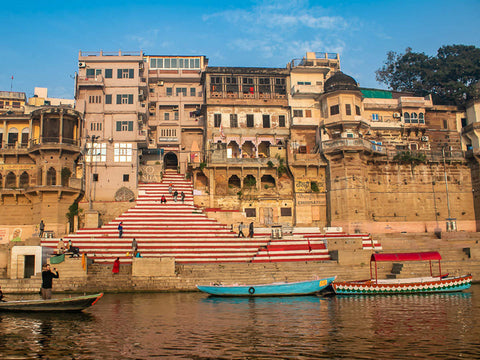2 minute read
Varanasi, also known as Kashi and Benaras, is the spiritual capital of India. Situated in Uttar Pradesh on the banks of river Ganga, it is among the most revered religious destinations. The city gets its name from two rivers; Varuna and Assi, which meet here. Varanasi has been synonymous with the majestic river Ganga and its numerous rivulets. Pilgrims throng these bathing ghats to take a holy dip to wash themselves off their sins. The ‘Ganga Aarti’ held every evening at ‘Dasashwamedha’ Ghat is a sight to behold!
Varanasi is famous for its production of silks and brocades with gold and silver thread work. Wooden toys, glass bangles, ivory work and brassware are also produced here. I visited this beautiful place a couple of years ago with my girl gang, and was mesmerised by the endless meandering lanes, little temples on every nook and the sheer magnanimity of the Ganges!

GHATS
The holy city of Varanasi, as old as the Indus Valley civilization, draws millions to its famous ghats every year to take a dip in the Ganges. The embankments made in steps of stone slabs along the river bank, are where pilgrims perform ritual ablutions. Most are bathing ghats, while others are used as cremation sites. Out of the 84 ghats, in particular note are the ‘Dashashwamedh’ Ghat, the ‘Panchganga’, the ‘Manikarnika’ Ghat and the ‘Harishchandra’, the last two being where Hindus cremate their dead. Hindus believe that dying here and getting cremated along the banks of the holy Ganges river allows one to break the cycle of rebirth and attain salvation, making it a major centre for pilgrimage.
A morning boat ride on the Ganges across the ghats is a popular tourist attraction. The extensive stretches of ghats in Varanasi enhance the riverfront with a multitude of shrines, temples and palaces built tier on tier above the water's edge, including the famous ‘Kashi Vishwanath’ temple, dedicated to the Hindu God Shiva.
As we sat on the ghats, gorging on steaming hot ‘Alu Puri’ watching the ‘Sadhus’ (sages) take their holy dips, I couldn’t help but fathom, how my cloth would look on them! I quickly removed my scarf and draped it on a ‘Sadhu’ standing nearby, who happily obliged and posed for pictures. A few more gathered and soon we had an audience. Our pleasure trip was now turning into a little business expedition.

FESTIVALS
We went there during November-December to be a part of the ‘Ganga Mahotsav’ or the Ganges festival. On this occasion, thousands of pilgrims gather on the banks of the ghats to light small lamps and set them afloat on the river. On Maha Shivratri, a procession of Lord Shiva proceeds from the ‘Mahamrityunjaya’ to the ‘Kashi Vishwanath’ temple. Every single day at dusk, most ghats have Hindu priests performing the ‘Ganga Aarti’. It is one of the must-see activities on every traveller’s itinerary.

The priests in-charge of performing the ‘Aarti’ prepare the set up by gathering elevated planks, layered brass lamps, idol of Ganga Devi, flowers, incense sticks, conch shells and other ritual paraphernalia. We eagerly stood along the banks with the other devotees, while few others took a boat ride from the opposite side of the river, to witness the awe-inspiring spectacle. It begins by lighting up the multi-tiered ceremonial brass lamps followed by a well synchronised rhythmic chanting of the holy mantras. While some of the priests blow the conch shells to sanctify the atmosphere, others begin waving the incense sticks to worship Mother Ganga. Once the goosebump inducing ‘Aarti’ is over, there is more of Sattva or purity in the air.







Leave a comment